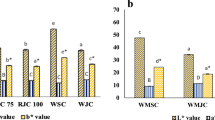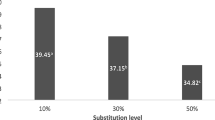Abstract
Wholegrain foods are becoming increasingly popular as a high fiber dietary supplement recommended for people with diabetes. In Indonesia, the incidence of diabetes mellitus has almost doubled recently and poses a significant health risk with the high prevalence of obesity and cardiovascular diseases. The present research aimed to develop cookie bars from foxtail millet, arrowroot flour, and kidney beans. The physical, chemical, and sensory properties were evaluated by selecting the best formula to test the glycemic index. Three formulae of cookie bars, which had different percentages of foxtail millet, kidney beans, and arrowroot flour were evaluated. The results showed that the three formulae (F1, F2, F3) had °Hue values of 53.77, 58.46, and 58.31, and breaking force of 8.37, 10.12, and 5.87 N, respectively. While all other nutritional content were significantly different between formulae, the total crude fat was not. The F2 cookie bar was selected and evaluated for the glycemic index because it has the best sensory properties, lowest total sugar and available carbohydrate content. F2 cookie bars that contain 15% foxtail millet, 15% arrowroot flour, and 30% of kidney beans have a glycemic index of 37.6 hence it could be classified as a low glycemic index cookie bar. In conclusion, our findings indicated that F2 cookie bars can be further developed as a suitable diabetic food since it has the best physico-chemical properties, sensory properties, and low glycemic index.


Similar content being viewed by others
References
AACC Report (2001) The definition of dietary fiber. Report of the Dietary Fiber Definition Committee to the Board of Directors of the American Association of Cereal Chemists. Cereal Foods World 46(3):112–126
Anju T, Sarita S (2010) Suitability of foxtail millet (Setaria italica) and barnyard millet (Echinochloa frumentacea) for development of low glycemic index biscuits. Malays J Nutr 16(3):361–368
AOAC (2005) Official methods of analysis, 18th edn. Association of Official Analytical Chemists, Washington
Asp NG, Johansson CG, Halmer H, Siljestrom M (1983) Rapid enzymatic assay of insoluble and soluble dietary fiber. J Agric Food Chem 31:476–482
Basic Health Research Survey (2013) Riset Kesehatan Dasar (Riskesdas). Kementerian Kesehatan Republik Indonesia, Jakarta
Behall KM, Hallfrisch J (2002) Plasma glucose and insulin reduction after consumption of breads varying in amylose content. Eur J Clin Nutr 56:913–920
Bennion M, Scheule B (2000) Introductory foods, 11th edn. Prentice-Hall, New York
Brouns F, Bjorck I, Frayn KN, Gibbs AL, Lang V, Slama G, Wolever TMS (2005) Glycemic index methodology. Nutr Res Rev 18:145–171
Chandalia M, Garg A, Lutjohann D, von Bergmann K, Grundy SM, Brinkley LJ (2000) Beneficial effects of high dietary fiber intake in patients with type 2 diabetes mellitus. N Engl J Med 342:1392–1398
DeVries JW (2012) Total dietary fiber. Medallion Laboratories, Minneapolis
Drlange (1994) Color review. Drlange application report, vol 8.0e. Drlange
Englyst HN, Kingman SM, Cummings JH (1992) The glycemic index of potatoes: the effect of variety, cooking method and maturity. Eur J Clin Nutr 53:249–254
FAO/WHO (1998) Carbohydrates in human nutrition. Report of a Joint FAO/WHO Expert Consultation (FAO Food and Nutrition Paper 66) Food and Agriculture Organization: April 14–18, 1997. Rome
Goni I, Garcia-Diz L, Manas E, Saura-Calixto F (1996) Analysis of resistant starch: a methods for foods and food products. Food Chem 56(4):445–449
Hoojjat P, Zabik ME (1984) Sugar-snap cookies prepared with wheat-navy bean-sesame seed flour blends. Cereal Chem 61:41–44
Hu P, Zhao H, Duan Z, Linlin Z, Wu D (2004) Starch digestibility and the estimated glycemic score of different types of rice differing in amylose contents. J Cereal Sci 40:231–237
HunterLab (1996) Insight on color. Application note, vol 8, no 7. HunterLab
Hutchings JB (1999) Food color and appearance, 2nd edn. Aspen Publishers Inc.
Krauss RM, Eckel RH, Howard B, Appel LJ, Daniels SR, Deckel-baum RJ, Erdman JW Jr, Kris-Etherton P, Goldberg IJ, Kotchen TA, Lichtenstein AH, Mitch WE, Mullis R, Robinson K, Wylie-Rosett J, St Jeor S, Suttie J, Tribble DL, Bazzarre TL (2000) AHA Dietary Guidelines: revision 2000: a statement for health-care professionals from the Nutrition Committee of the American Heart Association. Circulation 102:2284–2299
Kumalasari ID, Harmayani E, Lestari LA, Raharjo S, Asmara W, Nishi K, Sugahara T (2012) Evaluation of immunostimulatory effect of the arrowroot (Maranta arundinacea. L) in vitro and in vivo. Cytotechnology 64(2):131–137
Lawless HT, Heymann H (2010) Sensory evaluation of food—principles and practices, 2nd edn. Springer, New York
Lee C, Beuchat LR (1991) Functional and sensory properties of muffins and cookies containing dried fermented peanut milk. Lebensm-Wiss Technol 24:528–534
Marlett JA, Slavin JL (1997) Position of the American Dietetic Association: health implications of dietary fiber. J Am Diet Assoc 97(10):1157–1159. doi:10.1016/S0002-8223(97)00279-4
Marsono Y (2001) Glycemic index of selected Indonesian starchy foods. Indones Food Nutr Progr 8:15–20
McWilliams M (2001) Foods: experimental perspectives, 4th edn. Prentice-Hall, Englewood Cliffs
Moghaddam E, Vogt JA, Wolever TMS (2006) The effects of fat and protein on glycemic responses in nondiabetic humans vary with waist circumference, fasting plasma insulin, and dietary fiber intake. J Nutr 136:2506–2511
Odenigbo A, Rahimi J, Ngadi M, Amer S, Mustafa A (2012) Starch digestibility and predicted glycemic index of fried sweet potato cultivars. Funct Foods Health Dis 2(7):280–289
Perkumpulan Endokrinologi Indonesia (PEI) (2011) Konsensus Pengelolaan dan Pencegahan Diabetes Mellitus Tipe 2 di Indonesia. Jakarta, pp. 11–64
Pi-Sunyer FX (2002) Glycemic index and disease. Am J Clin Nutr 76(Suppl):S290S–S298S
Robbins S (2015) Glycemic Index (GI) food chart. http://www.hflsolutions.com/healthtips/weightloss/GI_foodchart.pdf
Sajilata MG, Singhal RS, Kulkarni PR (2006) Resistant starch—a review. Compr Rev Food Sci Food Saf 5:1–17
Sharma S, Singh N, Katyal M (2016) Effect of gelatinized-retrograded and extruded starches on characteristics of cookies, muffins, and noodles. J Food Sci Technol 53(5):2482–2491
USDA National Nutrient Database for Standard Reference (2015) Full Report (All Nutrients) 19015, Snacks, granola bars, hard, plain. http://ndb.nal.usda.gov
Verma M, Singh J, Kaur D, Mishra V, Rai GK (2015) Effect of various dehydration methods and storage on physicochemical properties of guava powder. J Food Sci Technol 52(1):528–534
Wolever TMS, Jenkins DJA (1986) The use of glycemic index in predicting the blood glucose response to mixed meals. Am J Clin Nutr 43:167–172
Young KW, Whittle K (1985) Colour measurement of fish minces using Hunter L, a, and b values. J Sci Food Agric 36:383–392
Acknowledgements
I would like to thank the Faculty of Medicine, Universitas Gadjah Mada (UGM) for the funds given through the Research Grant (Hibah Dana Masyarakat Dosen - Mahasiswa) in 2014. Thanks to the native speaker and professional editor in Klinik Bahasa (Language Clinic) Consultation, Office of Research & Publication, Faculty of Medicine, UGM for reviewing this article. I would like to express my gratitude to my students (Jap Kristianto Ade Cahyono, Aldino Dwi Caesar, and Titus Rian Pradita) who support this research as research assistants.
Author information
Authors and Affiliations
Corresponding author
Rights and permissions
About this article
Cite this article
Lestari, L.A., Huriyati, E. & Marsono, Y. The development of low glycemic index cookie bars from foxtail millet (Setaria italica), arrowroot (Maranta arundinacea) flour, and kidney beans (Phaseolus vulgaris). J Food Sci Technol 54, 1406–1413 (2017). https://doi.org/10.1007/s13197-017-2552-5
Revised:
Accepted:
Published:
Issue Date:
DOI: https://doi.org/10.1007/s13197-017-2552-5




